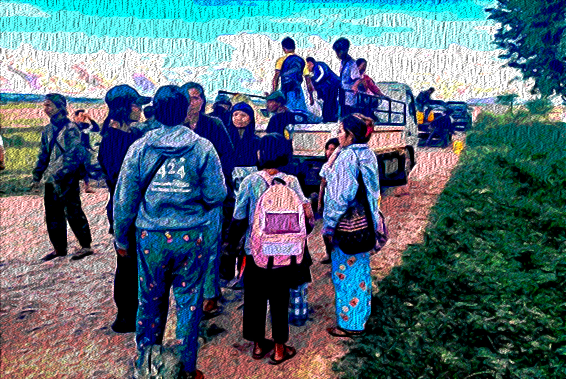Myanmar Spring Chronicle – December 18
Humanitarian Crisis Deepens with Over 2.5 Million War Refugees
MoeMaKa, December 19, 2023
**Escalating Hardships as Myanmar Grapples with Unprecedented Refugee Crisis**
As Myanmar witnesses an unrelenting escalation of armed conflict, the dire consequences are reflected in the soaring number of war refugees. In the aftermath of the military coup, a surge of individuals from towns and villages turned to armed resistance in response to the brutal suppression of anti-coup demonstrations. Young protestors, disillusioned by the crackdown on peaceful dissent, sought refuge in the path of armed resistance, aligning themselves with ethnic armed groups to confront the military dictatorship.
Over the course of two and a half years, nearly three years of relentless armed resistance, the military council finds itself unable to maintain control over numerous regions. Simultaneously, the revolutionary forces have yet to establish complete dominion. The widening armed conflict has given rise to a significant increase in the number of war refugees, fleeing not only from the base areas of armed groups but also from towns and villages where civilians believed to support them reside.
The number of internally displaced people, previously at 900,000 before the military takeover, has now surpassed 1 million. This figure excludes the approximately 1 million Rohingya refugees who sought shelter in neighboring Bangladesh from northern Rakhine State even before the military coup. When factoring in the refugees fleeing the conflict outside the country, the total exceeds 3.5 million. Myanmar now stands among the nations with the highest number of war refugees globally.
In contrast to regions like Ukraine, where European countries actively provide assistance in the face of Russian invasion, Myanmar struggles to garner significant international aid. While European nations view the Ukraine conflict as directly impacting them due to geographical proximity, Myanmar contends with the challenge of insufficient global support.
The Rohingya issue, persistently unresolved for over six years, highlights the declining support for refugees. Food rations received by Rohingya refugees in Rakhine State and on the Bangladesh side have steadily decreased from over $12 per month to a mere $8, making survival increasingly difficult. Reports suggest that refugee camps in Rakhine State are in a precarious state due to the military council’s blockade.
Refugees from Rakhine State, Karenni State, Northern Shan State, and Sagaing Region face myriad difficulties and life-threatening situations. In the wake of the recent 1027 operation in Northern Shan State, unexpected towns and villages are thrust into the throes of war.
Cities like Hsenwi, Kyaukme, Hsipaw, Namhkam, Muse, and Nawnghkio are grappling with the urgency of fleeing conflict. Tens of thousands of residents from Karenni State are escaping to southern Shan State following the battle for the state capital of Loikaw. In southern Myanmar, Kawkareik residents are similarly fleeing the war. Tanintharyi witnesses tens of thousands seeking refuge within the region. Fleeing war is no longer confined to rural areas; cities and state capitals are grappling with the unfolding crisis. Rakhine State, subjected to a complete blockade, faces the dual challenge of blockades and an escalating refugee exodus. The humanitarian crisis in Myanmar has reached unprecedented proportions, with millions struggling for survival in the midst of relentless conflict.

